It's usually popular to work with polygons with their vertices sorted CW or CCW in vectors(2*1 or 1*2 matrices). However, how to state polygons with holes in vectors?
I'm going to apply various process on these polygons, so I want a way of representing with which I could work easily or efficiently.(i.e how to state that kind of polygons in my program in order to ease my algorithms?)
polygons are 2D and I'm programming in MATLAB.
EDIT 1 : I'm going to calculate visibility graph of these polygons(with or without holes).

